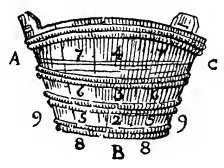The Origin of Springs
Table of Contents
64. The External Earth and the Origin of Springs
Some fragments of the external body E are concealed under the sea.
- Others are spread across fields.
- Others rise into mountains.

Springs and rivers continually flow into the sea. But their water never diminishes, nor does the sea increase or become sweet.
There are large cavities filled with water beneath fields and mountains.
Many vapors, i.e., water particles separated and rapidly moved by the force of heat, reach the surface of the external fields and the highest ridges of mountains.
We also see many of these vapors rising even further to the clouds and ascending more easily through the Earth’s channels, supported by its particles, than through the air, whose fluid and mobile particles cannot support them in the same way.
Once these vapors have ascended, they cool down with cold. They lose the form of vapor and turn back into water.
This water cannot descend through the same channels where vapor ascends because they are too narrow.
Instead, it finds wider paths in the gaps between the crusts of the surface of the external Earth.
These underground water paths lead obliquely along the slopes of valleys and fields.
Springs emerge where these subterranean water paths end on the surface of a mountain, valley, or field.
The streams formed by many springs together make rivers, flowing through the sloping parts of the Earth’s surface toward the sea.
65. Why the sea does not increase from the rivers flowing into it.
Many waters continually flow from the mountains to the sea.
- Yet the cavities from which they ascend can never be exhausted, nor can the sea increase.
This external Earth formed from the fragments of body E falling onto the surface of body C.
- Body
Cretained many very open channels for itself beneath these fragments.
Through these channels, water always returns from the sea towards the roots of the mountains as much as it departs from the mountains.
Thus, as the blood of animals circulates in their veins and arteries, water circulates in the veins and rivers of the Earth in a circular manner.
66. Why springs are not salty, and the sea does not become fresh.
Only particles of fresh water can ascend into springs because they are thin and flexible.
This fresh water continually returns to the sea through rivers. But the sea does not become fresh because an equal quantity of salt always remains in it.
Salt particles are rigid and hard. Thus salty seawater cannot easily be transformed into vapors nor pass through the oblique channels of the Earth.
67. Why do some wells contain salty water?
Salty water is found in some wells far from the sea.
When the Earth cracks in many places, non-percolated salty water can easily reach those wells.
This can occur either because:
- the sea’s surface is as high as the well’s bottom or
- salty particles from fresh water easily rise upward along the slope of a hard Earth where the paths are wide enough.
This phenomenon can be observed in a vessel with slightly inclined lips, as in ABC.

When salty water evaporates from it, the edges of the vessel are usually covered with a crust of salt.
68. Why salt is extracted from some mountains.
In some mountains, large masses of salt have congealed like stones.
When the sea water ascends there, and fresh water particles continue further, only salt remains in the cavities that happened to be there, filling them.
69. Nitre and other salts distinct from sea salt.
Sometimes, salt particles pass through some narrow channels of the Earth, losing something of their shape and quantity. They transform into nitre, sal ammoniac, or something similar.
Many particles of the Earth, elongated, non-branching, and quite rigid, originally had the forms of nitre and other salts.
For these forms are not located elsewhere than in the elongated, non-flexible, and non-branching nature of these particles. As different as they are, they compose various species of salt.
70. Vapors, Spirits, and Exhalations ascending from the interior to the exterior of the Earth
The following ascend from the Earth’s interior to the exterior:
- vapors derived from waters hidden underground
- many acrid spirits and oily exhalations
- vapors carrying particles of quicksilver and other metals
All fossil substances are formed from various mixtures of these.
Acrid spirits are particles of acrid juices and volatile salts. These:
- are separated from each other
- move so rapidly that the force with which they persistently move in all directions prevails over their gravity
Exhalations are branching particles. These are extremely fine and moved in the same way, of oily matter.
In waters and other juices and oils, particles only swim.
But in vapors, spirits, and exhalations, they fly.
71. How various mixtures give rise to different types of stones and other fossils.
Spirits fly with greater force and more easily permeate narrow channels in the Earth, where they are intercepted and adhere more firmly.
- These turn them into substances harder than exhalations or vapors.
Many kinds of stones and other non-transparent fossils arise from these 3 because of:
- their significant diversity
- the differences in the particles that they consist of
This occurs when they are trapped in narrow channels of the Earth and mixed with its particles.
Additionally, many types of transparent fossils and gems are formed when they are first gathered in the cracks and cavities of the Earth as juices.
Gradually, with their most slippery and fluid particles departing, the remaining ones adhere to each other.